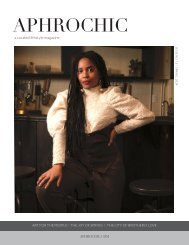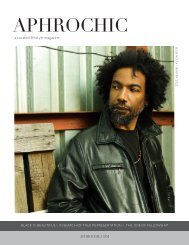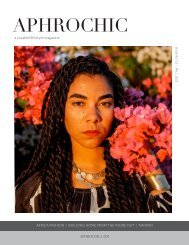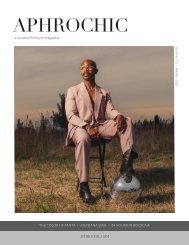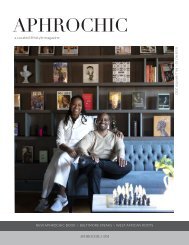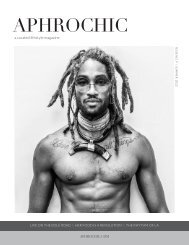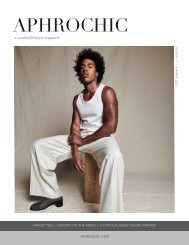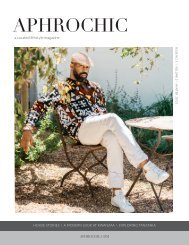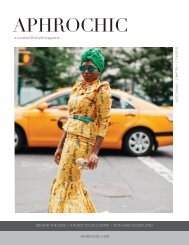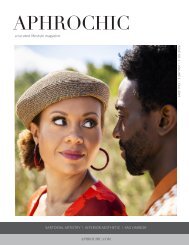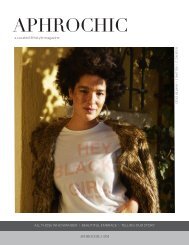AphroChic Magazine: Issue No. 8
This issue is about revolution, remembrance, and rebirth. In Dubai, Chef Alexander Smalls is launching a first-of-its-kind food experience celebrating the culinary revolution taking place in Africa. In New York, as fashion week returned, House of Aama launched a collection remembering the elegance of 20th century Black resort towns. In Philadelphia, Chanae Richards is carving out space for rest, relaxation and meditation. And in Los Angeles, our cover star, Jennah Bell, is part of a renaissance of music that is indie, soulful and written from the heart. In this issue we take you to The Deacon hotel designed by Shannon Maldonado. And in our Wellness section, we let you in our own road to rebirth, through the journey with long-haul COVID that has defined our life this past year. In our Reference section we explore new thoughts on the African Diaspora. Looking beyond the history behind the word to explore the idea itself, opening new worlds of possibility as we begin working to understand what the African Diaspora actually is. And we take you inside the importance of the emerging Black art scene heralded by the Obama portraits which, now well into their national tour, made a memorable stop at the Brooklyn Museum.
This issue is about revolution, remembrance, and rebirth. In Dubai, Chef Alexander Smalls is launching a first-of-its-kind food experience celebrating the culinary revolution taking place in Africa. In New York, as fashion week returned, House of Aama launched a collection remembering the elegance of 20th century Black resort towns. In Philadelphia, Chanae Richards is carving out space for rest, relaxation and meditation. And in Los Angeles, our cover star, Jennah Bell, is part of a renaissance of music that is indie, soulful and written from the heart.
In this issue we take you to The Deacon hotel designed by Shannon Maldonado. And in our Wellness section, we let you in our own road to rebirth, through the journey with long-haul COVID that has defined our life this past year.
In our Reference section we explore new thoughts on the African Diaspora. Looking beyond the history behind the word to explore the idea itself, opening new worlds of possibility as we begin working to understand what the African Diaspora actually is. And we take you inside the importance of the emerging Black art scene heralded by the Obama portraits which, now well into their national tour, made a memorable stop at the Brooklyn Museum.
Create successful ePaper yourself
Turn your PDF publications into a flip-book with our unique Google optimized e-Paper software.
HOT TOPIC<br />
have portraits with such a background. But<br />
that’s only the beginning of the meaning<br />
layered in each of these images. True to<br />
form, both Wiley and Sherald found ways to<br />
place the first Black President and First Lady<br />
in direct conversation with the meta-narratives<br />
that surrounded them as Black people<br />
in American popular culture even while<br />
occupying the nation’s highest office.<br />
In his image, Barack Obama is a Black<br />
man — an African — in nature. For much of<br />
early African American history, the image of<br />
the African in nature was often used to dehumanize,<br />
depicting us as little more than<br />
primates, incapable of the levels of civilization<br />
evinced by those who enslaved us<br />
and grateful for having been brought into<br />
modernity. Yet in this image, Barack Obama,<br />
Black and President of the the United States,<br />
is surrounded by nature, but wrapped in the<br />
symbols of “civilization.” His suit, his watch,<br />
the chair he’s sitting on, and even wedding<br />
ring all mark him as a sophisticated man of<br />
the modern age, a stark contrast to those<br />
early images. Even the intelligent gaze and<br />
inviting demeanor depicted in the image<br />
go against common tropes of Black men as<br />
predatory and dangerous.<br />
Similarly, Michelle Obama’s portrait<br />
can be seen speaking to those tropes of<br />
common knowledge usually directed at<br />
Black women. The soft lines of the portrait<br />
depict a Black woman who is beautiful,<br />
soft, strong, sophisticated and feminine —<br />
a conspicuous absence in many museums<br />
and collections outside of those shows and<br />
events specifically devoted to such representations.<br />
In its presentment of Mrs.<br />
Obama, the painting takes away many of the<br />
usual points of attack for African American<br />
women. Her skin tone is more gray than<br />
brown. Her body, hidden beneath the<br />
flowing expanse of the dress is removed<br />
as a potential focus of attention. And to a<br />
society that’s expectation of “free access”<br />
to Black women — from their mannerisms<br />
and their hair to their joy and their “magic,”<br />
— is the subject of long and ongoing debate,<br />
Michelle’s posture of quiet reserve speaks<br />
volumes.<br />
Remember the Time<br />
We’ve come a long way in our fight in<br />
this country, and we’ve got a long way left to<br />
go. When we stop to count our wins, we win<br />
again and we get more of what we need to<br />
push a little bit further. To have had Barack<br />
and Michelle Obama leading this nation and<br />
some of its most important discourses was<br />
undoubtedly one of our biggest wins to date.<br />
Sandwiched between the tenures of George<br />
W. Bush and Donald Trump, the Obama<br />
Presidency was 8 years of relative calm and<br />
progressive thought built around reason,<br />
compromise and most of all, hope.<br />
And as we work to recover some sense<br />
of that state amid the tumult of everything<br />
that’s followed since the Obamas left the<br />
White House, seeing these portraits is more<br />
than a great excuse to go to a museum — it’s a<br />
chance to remember that feeling again and a<br />
chance to inspire something new, not just for<br />
us but for the next generation. As Michelle<br />
Obama said herself, “One visit, one performance,<br />
one touch, and who knows how you<br />
could spark a child’s imagination.” AC<br />
118 aphrochic issue eight 119




